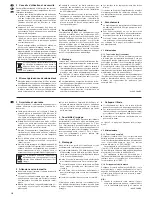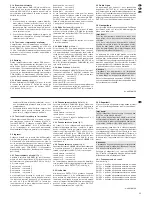
sen (z. B. durch ausreichend viele Schweiß-
punkte). Eventueller Lack am Kontaktpunkt muss
vollständig entfernt werden.
2. Zur Vermeidung von Masseschleifen muss die
Masse des Autoradios an die Stelle ge legt wer-
den, an der auch die Endstufe an Masse liegt.
6.1.3 Steuerspannung zum Einschalten
Die Car-HiFi-Endstufe wird durch eine Steuerspan-
nung von +12 V am Anschluss REM (11) ein- und
ausgeschaltet. Den Anschluss REM mit dem 12-V-
Schaltausgang vom Auto radio verbinden (Anschluss
für eine Motor
antenne, eventuell mit der Motor
-
antenne parallel schalten).
6.2 Eingänge
Die Endstufe wird über Cinch-Kabel mit den Line-
Ausgängen am Autoradio (oder einer anderen Signal-
quelle) verbunden. Sind am Autoradio jedoch keine
Line-Ausgänge vorhanden, können die Lautsprecher-
ausgänge des Autoradios über einen Audio-Übertra-
ger (z. B. FGA-22HQ*) mit den Line-Eingängen der
Endstufe verbunden werden. Der Anschluss richtet
sich nach der ge wünschten Be triebsart der Endstufe:
6.2.1 4-Kanalbetrieb
(Abb. 3)
Den Schalter CHANNEL (8) für den 4-Kanal-Betrieb
in die Position „4“ stellen. Die Ausgänge des Auto -
radios wie folgt mit den Eingängen INPUT CH 1 bis
CH 4 (1 und 2) verbinden:
Front links
auf Kanal 1
Front rechts
auf Kanal 2
Rear links
auf Kanal 3
Rear rechts
auf Kanal 4
Sind am Autoradio keine Ausgänge für die hinteren
Kanäle (Rear) vorhanden, den Ausgang des linken
Kanals über ein Y-Kabel (z. B. CBA-25/SW*) mit
den Eingangsbuchsen der Kanäle 1 und 3 verbin-
den und den Ausgang des rechten Kanals über ein
weiteres Y-Kabel mit den Eingangsbuchsen der
Kanälen 2 und 4.
6.2.2 Aktiver 2-Wegebetrieb
(Abb. 4)
Den Schalter CHANNEL (8) für den aktiven 2-Wege-
betrieb in die Position „2“ stellen. Die Ausgänge des
Autoradios mit den Eingängen INPUT CH 3 und
CH 4 (2) verbinden:
linker Kanal
auf Kanal 3
rechter Kanal auf Kanal 4
Der Kanal 1 er hält das Signal vom Eingang 3 und
der Ka nal 2 vom Eingang 4.
6.2.3 Brückenbetrieb
(Abb. 5)
Sollen die Kanäle 1 und 2 in Brückenschaltung den
linken Lautsprecher antreiben sowie die Kanäle 3
und 4 in Brückenschaltung den rechten Lautspre-
cher, den Ausgang des linken Kanals am Autoradio
über ein Y-Ka bel (z. B. CBA-25/SW*) mit den Ein-
gängen INPUT CH 1 und CH 2 (1) verbinden und
den Ausgang des rechten Kanals über ein weiteres
Y-Kabel mit den Eingängen INPUT CH 3 und CH 4
(2). Den Schalter CHANNEL (8) hierfür in die Posi-
tion „4“ stellen.
6.2.4 3-Kanalbetrieb
(Abb. 6)
Den Schalter CHANNEL (8) für den 3-Kanalbetrieb
in die Position „3“ stellen. Die Ausgänge des Auto -
radios wie folgt mit den Eingängen INPUT (1 und 2)
verbinden:
linker Kanal
auf Kanal 1
rechter Kanal auf Kanal 2
Subwoofer L auf Kanal 3
Subwoofer R auf Kanal 4
Sind am Autoradio keine Ausgänge für einen Sub-
woofer-Verstärker vorhanden, die Eingänge der
Kanäle 3 und 4 mit den beiden Buchsen OUTPUT
(9) verbinden (siehe Abb. 6).
6.3 Line-Ausgang
An den beiden Buchsen OUTPUT (9) liegt das
Monosignal der Eingänge 1 – 4 an. Soll ein
Sub -
woofer-Verstärker in die Car-HiFi-Anlage eingesetzt
werden und sind am Autoradio keine Ausgänge für
einen Subwoofer-Verstärker vorhanden, können die
Eingänge des Subwoofer-Verstärkers an die Buch-
sen OUTPUT angeschlossen werden (siehe ggf.
auch Kap. 6.2.4).
6.4 Lautsprecher
Es lassen sich Full-Range-Lautsprecher (2- oder 3-
Wege-Lautsprecher), Mittelhoch
töner, Basslaut-
sprecher oder ein Subwoofer betreiben.
Die größte Ausgangsleistung wird beim Anschluss
von 2-Ω-Lautsprechern oder einer Lautsprecher-
gruppe mit einer Gesamtimpedanz von 2 Ω pro
Kanal erreicht (z. B. zwei 4-Ω-Lautsprecher parallel
ge schaltet). Es können jedoch auch einzelne 4-Ω-
Lautsprecher angeschlossen werden, wobei sich
die Ausgangsleistung etwas verringert.
Die Lautsprecher an die Klemmen SPEAKER (16)
anschließen. Der genaue Anschluss richtet sich
nach der gewünschten Betriebsart der Endstufe:
6.4.1 4-Kanalbetrieb
Siehe auch Abb. 3.
CH 1 L+ = Pluspol
Lautsprecher links vorne
CH 1 L- = Minuspol Lautsprecher links vorne
CH 2 R+ = Pluspol
Lautsprecher rechts vorne
CH 2 R- = Minuspol Lautsprecher rechts vorne
Achtung!
Die Impedanz der Lautsprecher bzw. die Gesamt -
impedanz von Lautsprechergruppen, die im Brü -
ckenbetrieb angetrieben werden, darf 4 Ω nicht
unterschreiten!
Wichtig!
Alle Lautsprecher müssen 2-polig angeschlossen
werden, d. h. ohne ge meinsamen Masseanschluss.
Bei der Auswahl geeigneter Lautsprecher unbe-
dingt deren mechanische und elektrische Belast-
barkeit im Zusammenhang mit der ge nutzten End-
stufen leistung berücksichtigen (siehe auch
technische Daten der Endstufe auf Seite 8).
number of welding points). Any lacquer at the
point of contact must completely be removed.
2. To prevent ground loops, the ground of the car
radio must be applied at the place where also the
power amplifier is grounded.
6.1.3 Control voltage for switching-on
The car HiFi power amplifier is switched on and off
by a control voltage of +12 V at the terminal REM
(11). Connect the terminal REM to the 12 V control
output of the car radio (connection for a motor an -
tenna, if necessary, to be connected in parallel to the
motor antenna).
6.2 Inputs
The power amplifier is connected via cables with
RCA connectors to the line outputs at the car radio
(or another signal source). However, if the car radio
is not equipped with line outputs, the speaker out-
puts of the car radio can be connected via an audio
transformer (e. g. FGA-22HQ*) to the line inputs of
the power amplifier. The connection depends on the
desired operating mode of the power amplifier:
6.2.1 4-channel operation
(fig. 3)
Set the switch CHANNEL (8) for the 4-channel oper-
ation to position “4”. Connect the outputs of the car
radio to the jacks INPUT CH 1 to CH 4 (1 and 2) as
follows:
front left
to channel 1
front right
to channel 2
rear left
to channel 3
rear right
to channel 4
If the car radio is not equipped with outputs for the
rear channels, connect the output of the left channel
via a Y cable (e. g. CBA-25/SW*) to the input jacks
of the channels 1 and 3 and the output of the right
channel via another Y cable to the input jacks of the
channels 2 and 4.
6.2.2 Active 2-way operation
(fig. 4)
Set the switch CHANNEL (8) for the active 2-way
operation to position “2”. Connect the outputs of the
car radio to the jacks INPUT CH 3 and CH 4 (2):
left channel
to channel 3
right channel to channel 4
The channel 1 receives the signal from input 3 and
the channel 2 from input 4.
6.2.3 Bridge operation
(fig. 5)
If the channels 1 and 2 in bridge operation are to
drive the left speaker and the channels 3 and 4 in
bridge operation the right speaker, connect the out-
put of the left channel at the car radio via a Y cable
(e. g. CBA-25/SW*) to the jacks INPUT CH 1 and
CH 2 (1) and the output of the right channel via an -
other Y cable to the jacks INPUT CH 3 and CH 4 (2).
For this purpose, set the switch CHANNEL (8) to
position “4”.
6.2.4 3-channel operation
(fig. 6)
Set the switch CHANNEL (8) for the 3-channel oper-
ation to position “3”. Connect the outputs of the car
radio to the jacks INPUT (1 and 2) as follows:
left channel
to channel 1
right channel to channel 2
subwoofer L
to channel 3
subwoofer R to channel 4
If the car radio is not equipped with outputs for a sub-
woofer amplifier, connect the inputs of the channels 3
and 4 to the two jacks OUTPUT (9) [see fig. 6].
6.3 Line output
The mono signal of the inputs 1 to 4 is available at
both jacks OUTPUT (9). If a subwoofer amplifier is
to be inserted into the car HiFi system and if the car
radio is not equipped with outputs for a subwoofer
amplifier, the inputs of the subwoofer amplifier can
be connected to the jacks OUTPUT (also see chap-
ter 6.2.4, if necessary).
6.4 Speakers
It is possible to use full range speakers (2-way or
3-way speakers), mid-high range speakers, bass
speakers, or a subwoofer.
The highest output power is reached when connect -
ing 2 Ω speakers or a speaker group with a total im -
pedance of 2 Ω per channel (e. g. two 4 Ω speakers
connected in parallel). However, it is also possible to
connect individual 4 Ω speakers in which case the
output power is slightly reduced.
Connect the speakers to the terminals SPEAKER
(16). The exact connection of the speakers depends
on the desired operating mode of the power amplifier:
6.4.1 4-channel operation
Also see fig. 3.
CH 1 L+ = positive pole
speaker left front
CH 1 L- = negative pole speaker left front
CH 2 R+ = positive pole
speaker right front
CH 2 R- = negative pole speaker right front
CH 3 L+ = positive pole
speaker left rear
CH 3 L- = negative pole speaker left rear
CH 4 R+ = positive pole
speaker right rear
CH 4 R- = negative pole speaker right rear
Attention!
The impedance of the speakers or the total imped-
ance of speaker groups which are driven in bridge
operation must not fall below 4 Ω!
Important!
All speakers must be connected with 2 poles, i.e.
without common ground connection.
When choosing suitable speakers, pay in any case
attention to their mechanical and electrical capabil -
ity in connection with the power used of the power
amplifier (also see specifications of the power
amplifier on page 8).
6
GB
D
A
CH
* von CARPOWER
* by CARPOWER







































